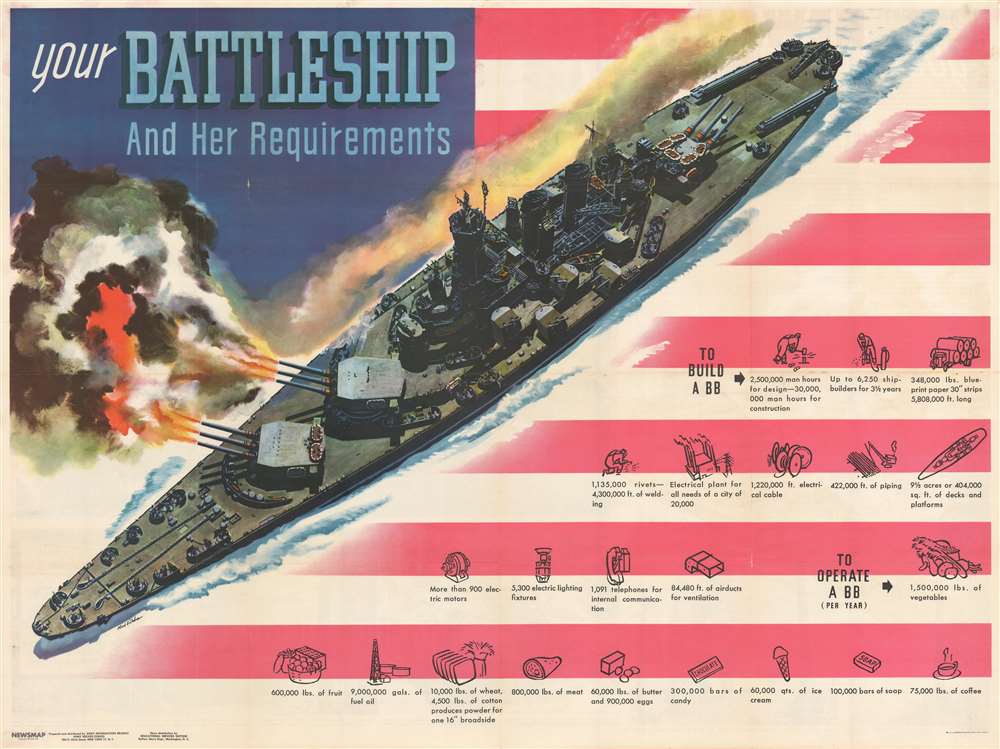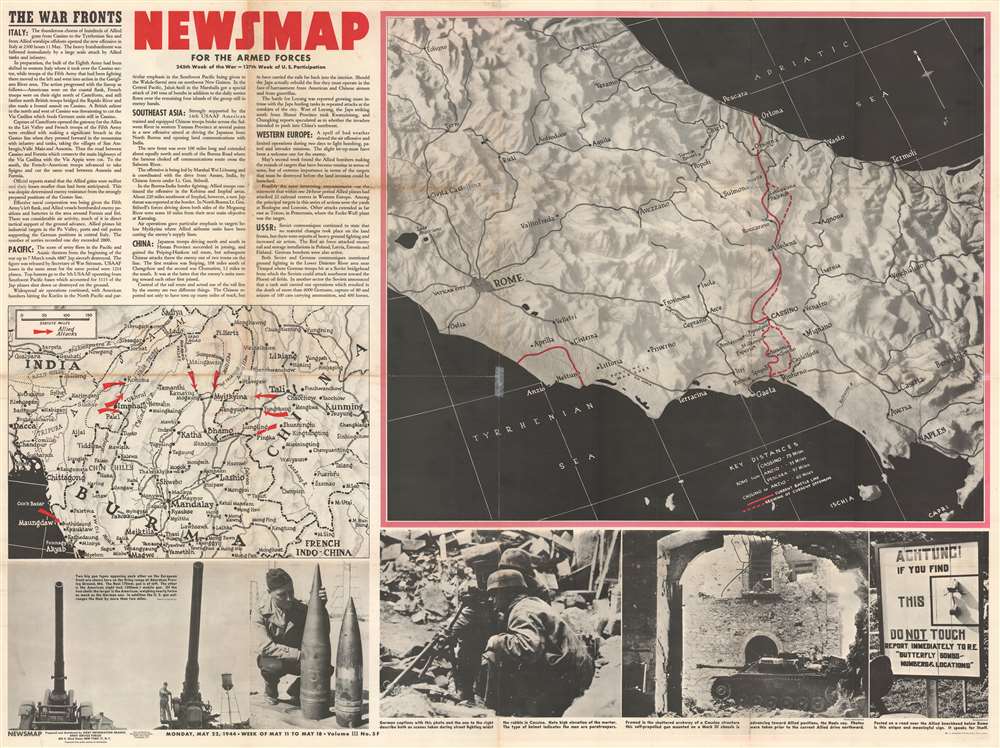This item has been sold, but you can get on the Waitlist to be notified if another example becomes available, or purchase a digital scan.
1944 Army Information Branch Newsmap WWII Propaganda Broadside of a Battleship
YourBattleship-newsmap-1944$500.00

Title
Your Battleship And Her Requirements. / NEWSMAP for the Armed Forces. Monday, May 22, 1944. 245th Week of the war - 127th Week of U.S. Participation.
1944 (dated) 35 x 47 in (88.9 x 119.38 cm)
1944 (dated) 35 x 47 in (88.9 x 119.38 cm)
Description
This is a 1944 Army Orientation Branch newsmap propaganda broadside of a North Carolina class battleship. The battleship steams across an American flag and fires a salvo from its two forward gun batteries. Smaller gun batteries flank the ship's superstructure, and smaller anti-aircraft batteries dot the rest of the ship's deck, from bow to stern. Infographics concerning the construction and operation of a 'BB' (U.S. Navy abbreviation for battleships) appear in the right quadrant, over the stripes of the flag. Nearly the first three rows detail parts of a battleship's construction (which took a force of 6,250 shipbuilders 3.5 years to finish) and required 1,135,000 rivets; 1,220,000 feet of electrical cable; 422,000 feet of piping; 5,300 electric light fixtures; and 1,091 telephones. Operational statistics, given per year, include: 9,000,000 gallons of fuel oil; 60,000 pounds of butter; 300,000 candy bars; 100,000 bars of soap; and 75,000 pounds of coffee.
North Carolina Class Battleships
Two North Carolina class battleships were built for the U.S. Navy in the late 1930s and early 1940s, the North Carolina and the Washington. Over fifty designs were considered before the final design was selected. The North Carolina and Washington could maintain thirty knots (thirty-five mph) and had a main battery of nine sixteen-inch guns.USS North Carolina
USS North Carolina was commissioned on April 9, 1941 and saw service in the Pacific during World War II. She fought in several battles around Guadalcanal and was hit by a torpedo on September 15, 1942. She was the first modern battleship struck by a torpedo and limped her way back to Pearl Harbor for repairs. After the repairs, North Carolina served as a carrier escort for the rest of 1942 and most of 1943. She saw extensive action in 1944 as a carrier escort. She was part of the invasion fleets that attacked Leyte and Luzon in the Philippines and provided bombardment support for the invasion of Iwo Jima in 1945. North Carolina was decommissioned on June 27, 1947, and was sold to the state of North Carolina to be a museum ship on August 8, 1961.USS Washington
USS Washington was commissioned on May 15, 1941 but suffered the same longitudinal vibration problems as North Carolina, which delayed her reaching active service. Once repaired, Washington left for joint exercises with the British Home Fleet in early 1942, and then worked as an escort for Arctic convoys through mid-July. She left for the Pacific in August, after a month-long overhaul, and participated in actions around Guadalcanal and the Solomons Campaign. Like her sister, Washington served as a carrier escort and participated in the Mariana and Palau Islands campaign, including during the Battle of the Philippine Sea. She also participated in the shore bombardment of the assault on Peleliu. She supported the invasion of Iwo Jima and bombarded Okinawa in March and April 1945 before being sent to Puget Sound, Washington, for an overhaul. This overhaul lasted until after V-J Day, so she was ordered to Philadelphia for a refit to help ferry troops home from Europe.Verso Content
As with all Newsmaps, content detailing the most current events on the war fronts fills the opposite side. Here, paragraphs inform the viewer of Allied victories in Italy, the Pacific, and Southeast Asia. More text recounts Japanese gains in China, Allied bombing raids in Western Europe, and a lack of progress on the Eastern Front. A large map of central Italy occupies over half the sheet and illustrates the Allied gains along the battle line, which stretches across the peninsula. These gains would have been of particular interest to contemporary viewers because German forces had impeded the Allied advance for months. A smaller map details actions in Southeast Asia. Printed photographs occupy the entire bottom border. The one on the far right hopes to alert soldiers to 'butterfly bombs' and prevent casualties. The next two are reprints of German photographs taken in the ruins of Cassino, Italy. The two in the left corner present a German artillery piece (on the left) and an American artillery piece (right). Per the caption, the larger of the two shells is for the American gun, which is twice the size of the German shell, and the American gun has a range more than two miles further than its German opponent.Publication History and Census
This map was created and distributed by the Army Information Branch and was published on May 22, 1944, to cover the events of May 11 through May 18. Nine examples are cataloged in OCLC and are part of the institutional collections at the Boston Athenaeum, Denison University, Ohio Wesleyan University, the University of Missouri-Columbia, Wichita State University, the Denver Public Library, Davidson College, the Library of Michigan, and Southern Illinois University at Edwardsville.Cartographer
The Army Orientation Branch (1940 - c. 1949) created special maps for teaching the Army Orientation Course and was based at The Pentagon in Washington, D.C. The Army Orientation Branch was part of the Information and Education Division. More by this mapmaker...
Source
NEWSMAP Series.
Newsmaps were published weekly between April 1942 and March 1946. Their content usually featured world maps, short summaries of the week’s military action, and photographs of troops and materiel. Early Newsmaps were printed on one side only, but, later in the war, they were printed on both sides, with the reverse bearing large-format maps, photographs, or other visual information. Several different versions of Newsmaps were produced: a large domestic version, a smaller overseas version, and an industrial version, which included more information about war production efforts. Two other editions appear in the United States Government Publications Monthly Catalogs, a 'Newsmap Special Edition' and a 'Newsmap Special Supplement for Special Training Units'.
Per the National Archives and Records Administration, ‘NEWSMAPS were not issued for general distribution. The posters were distributed to military installations, government and civilian groups working on War Department projects, and certain depository libraries, as designate by Congress, and one copy to Congressmen, if requested.’ The importance of the Newsmaps to the Army is related in the 1944 Basic Field Manual for The Special Service Company. The Manual states that as soon as the company reaches its destination ‘the company commander should contact the Special Service Branch in theater of operations headquarters, for copies of the weekly Newsmap.’ Also per the Manual
Per the National Archives and Records Administration, ‘NEWSMAPS were not issued for general distribution. The posters were distributed to military installations, government and civilian groups working on War Department projects, and certain depository libraries, as designate by Congress, and one copy to Congressmen, if requested.’ The importance of the Newsmaps to the Army is related in the 1944 Basic Field Manual for The Special Service Company. The Manual states that as soon as the company reaches its destination ‘the company commander should contact the Special Service Branch in theater of operations headquarters, for copies of the weekly Newsmap.’ Also per the Manual
The librarian should check the weekly Newsmap as soon as it is made available and should post it in a conspicuous place. He should take steps to see that the place where the Newsmap is posted is made known to all troops of the area in which the company or platoon is operating. This can be done effectively through notices in soldier newspapers, verbal announcements by those directly in charge of troops, and by posting announcements on bulletin boards.
Condition
Good. Exhibits wear and toning along original fold lines. Exhibits some foxing. Verso repairs to fold separations. Two small areas of infill. The War Fronts text, maps, and printed photographs on verso.
References
OCLC 48030926; 60843940.




